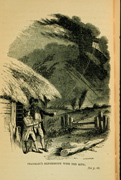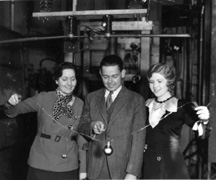

Science StandardsPhysical Science — As a result of the activities in grades K-4, all students should develop an understanding of light, heat, electricity, and magnetism. Electricity in circuits can produce light, heat, sound, and magnetic effects. Electrical circuits require a complete loop through which an electrical current can pass. — As a result of their activities in grades 5–8, all students should develop an understanding of transfer of energy. Electrical circuits provide a means of transferring electrical energy when heat, light, sound, and chemical changes are produced. — As a result of their activities in grades 9-12, all students should develop an understanding of motions and forces; interactions of energy and matter. Electricity and magnetism are two aspects of a single electromagnetic force. Moving electric charges produce magnetic forces, and moving magnets produce electric forces. These effects help students to understand electric motors and generators. Electromagnetic waves result when a charged object is accelerated or decelerated. Electromagnetic waves include radio waves (the longest wavelength), microwaves, infrared radiation (radiant heat), visible light, ultraviolet radiation, x-rays, and gamma rays. The energy of electromagnetic waves is carried in packets whose magnitude is inversely proportional to the wavelength.
|
"Whoever wishes to get a true appreciation of the greatness of our age should study the history of electrical development." — Nikola Tesla, 1915 Charge up your classroom with cool experiments, awesome demonstrations, and noteworthy historical information about electricity. Learn about people who made major scientific contributions that opened up new frontiers leading to household lighting, the long-distance transmission of power, and electronic devices that made life easier. Visit these Web sites for background information, illustrations, explanations, lessons, and insight into the world of electricity. HISTORICAL BACKGROUND Franklin and His Electric Kite How did Franklin's experiment with the kite work? Why did Franklin remain unscathed while holding the string? Why was he shocked when he touched the key? Answers to these questions plus a wealth of historical information can be uncovered at this site. Inventing Entertainment: The Motion Pictures and Sound Recordings of Thomas Edison This American Memory collection from The Library of Congress features 341 motion pictures, 81 disc sound recordings, and other related materials, such as photographs and original magazine articles. In addition, there is a timeline and biography about Thomas Edison. Edison is well known for his many inventions, Franklin for his kite experiment, but who is Nikola Tesla and what scientific contributions did he make during his lifetime? Nikola Tesla was considered a genius in the area of low-frequency electrical power generation and transmission at the turn of the 20th century. Some of his key inventions were alternating current, the Tesla coil, and remote control. Tesla also conducted experiments on transmitting electrical power from one point to another without wires. Unfortunately, he was decades ahead of the wireless technology, and the project was abandoned. George Westinghouse purchased Tesla's patents, but it would not be until the 1930s that another attempt was made to transmit power without wires in the confines of the Westinghouse Laboratory. [See the sidebar "An Early Attempt at Wireless Transmission."] WORLD OF ELECTRICITY Ippex Online: Electricity and Magnetism Students will enjoy this virtual learning module on electricity and magnetism. Concepts covered include charged particles, electric current, resistance, voltage, and circuits. Through a series interactive visualizations, students will learn about static charges, how to construct a circuit, and the relationship between magnetism and electricity. This project originated in 1996 at the Princeton University Plasma Physics Laboratory as part of a National Science Foundation grant, administered by the Center for Improved Engineering and Science Education (CIESE) at the Stevens Institute of Technology. Why is it safe to be in a car during a lightning storm? (The answer is not that it has rubber tires.) How did Benjamin Franklin conduct his kite experiment? What are Tesla coils? Learn fascinating facts about electricity at the Boston Museum of Science site, demonstrated by the Van De Graaf generator. Robert Van De Graaf built the generator in 1931 to conduct early atom smashing and high-energy X-ray experiments. The Massachusetts Institute of Technology donated the generator to the museum in the early 1950s. Today it is used to educate the public and school children about electricity and lightning. The first question you may ask is what is electricity? Electricity has several different and contradictory meanings. According to this article written by Bill Beatty, electrical engineer, there is no such thing as "electricity." Instead, there are names for all the separate phenomena associated with the term. Read this thought-provoking essay and see what you think. SAFETY TIPS Four sections target different audiences. In Louie's Space, grades 1-4 are given a tour through the science, history, and safety of electricity. New Frontiers is designed for grades 5-8 and covers safety, conservation, and careers. Mind Power is well suited for teenagers in grades 8-12, with loads of information for reports, including brief biographies and illustrations of inventors. Rounding out the site is the Teachers Lounge, which contains experiments, a glossary, and links to other sites. Electrical Safety World usesvideos to answe rquestions about elevtricity and be safe. LESSON PLANS Check out this PBS site for an excellent visual demonstration of the differences between direct current and alternating current. The scientific principles behind batteries, copper wire, and light bulbs are also described. All sorts of teacher-tested experiments are presented in the Exploratorium's Snackbook series. In the electricity section, discover how a pinball machine works, make a simple motor, start an electric flea circus, and investigate electric phenomena. Sparks of Light Create a lab in your classroom. Decide on a list of experiments. Organize your students into groups of scientists and let them decide which experiment to try. Design how you want to conduct the experiments. You may want to begin with a hypothesis or determine probability. Have your students keep a journal or log. Use a spreadsheet to chart and evaluate the results. Watch as your scientists light up with awe over the wonders of electricity. |
Bright IdeaThis is a great way to introduce electricity to students or to evaluate their knowledge. See how many ways your students can light a bulb with the following materials. Materials: * Insulated
wire, 6 inches long; or a 1/2-inch-wide, 6-inch-long piece
of aluminum foil Procedure: 1. Strip the ends of the wire so 3/4-inch to 1 inch is showing. 2. Experiment with connecting the wire/aluminum foil, battery, and light bulb until the bulb lights up. 3. Sketch your designs and mark what worked and didn't work. Questions: What differences are there between the two ends of the battery? Where should the wires be placed? Why? What happened to the battery when both ends of the wire/aluminum foil were connected to it? Why? What were you creating through this experiment? What kind of current is being used? Caution: The battery becomes hot when doing this experiment. Data Collection Lesson In this activity you will measure the voltage of a "fruit battery*" using a voltmeter. An Early Attempt at Wireless Transmission
The light shown in the picture needs no current. It lights merely by reason of its presence in an ultra-high-frequency field. The field is produced by a standing wave oscillator, which sends out from the antenna overhead 15,000 watts of power as ultra-short radio waves (known as microwaves today). This tremendous power lights all lamp bulbs within 40 feet, cooks food in a matter of seconds, and raises body temperature 1 degree per minute—all due to the electro-magnetic field. In the picture, H.V. Noble, Westinghouse research engineer, hurriedly explains the phenomenon to Evelyn Tray (left) and Vera Goga, because, after a few more minutes in the field's influence, they too will feel "lit."
|
||
|
||||
Updated January 5, 2019
© 1996 - 2015 Linda C. Joseph
All Rights Reserved
All CyberBee Graphics are Trademarked
Graphics by
Darlene Vanasco/Creative Director
Erika Taguchi/Designer & Illustrator
Hosting Provided by Iwaynet

